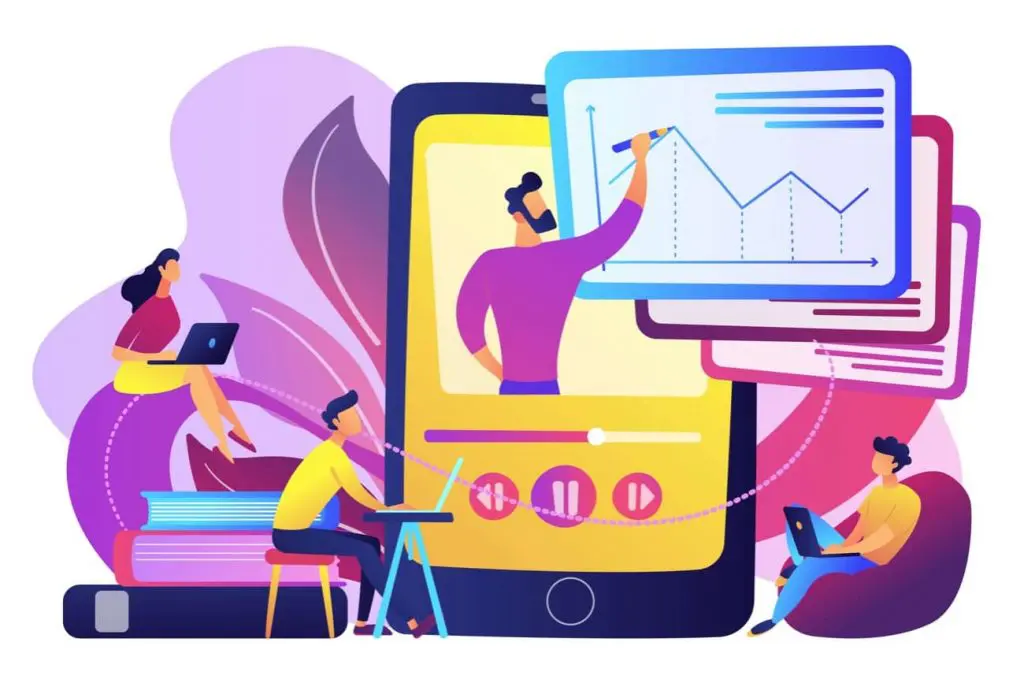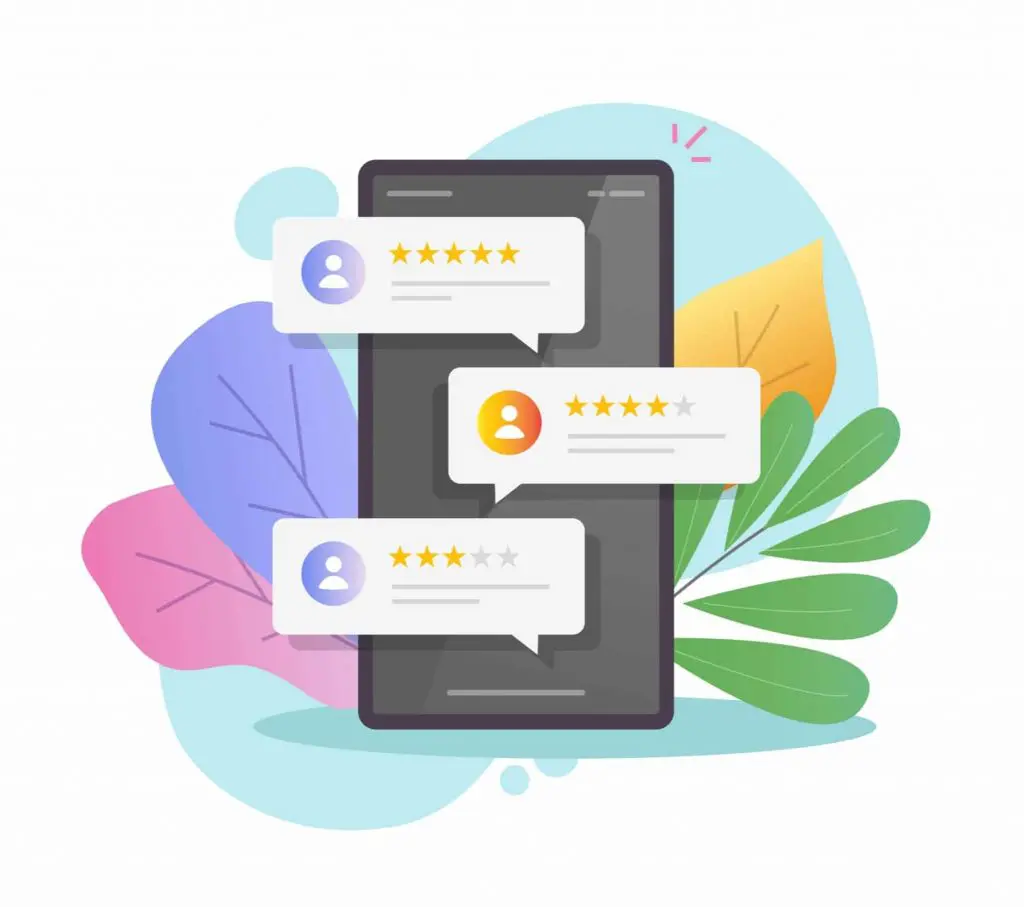Online teaching jobs from home : Create best selling courses- part 3

Table of Contents
In this series of posts, we will explore online teaching jobs from home
How Video Helps You Get More Sales
Have you ever thought about how much screens influence us these days? People watch hours and hours a day, whether it’s in the form of live TV, movies, or online videos.
When it comes to promoting your online course, you can use screen time to your advantage by adding video to your sales page.
How will video help me sell my online course?
It has been proven that a sales page with video converts at a higher rate than a sales page without video. This is because video establishes a connection between you and your potential customers that text alone can’t accomplish.
The proof of the effectiveness of video is impossible to deny. Even well-respected sales page tool providers like LeadPages and ClickFunnels automatically add a space for a video on their sales page templates.
Including a video on your sales page is especially important if you’re selling online courses. During students’ participation in your course, they’ll have limited face-to-face interaction with you. A video is a way to get engagement from the beginning.
What should I put in my video?
Your sales page video should be short (about 2 minutes). Even if it’s short, it must have good content. No one wants to waste their time – even 2 minutes – on a video that they gain nothing from.
- Plan a quick, concise way of introducing yourself, e.g. “I’m XX and I help moms who want to save an hour every day,” or “I’m XX, your success color consultant”
- Prepare one key point about how your course can solve a problem for the viewer
- Include a clear call to action
You could also set up a short series of teaser videos in the weeks leading up to your launch date.
If you want to really harness the power of video, use it as part of your online course, e.g. to introduce the course, to demonstrate something, to reinforce a message, etc.
What about the technical stuff?
You want your video to look as professional as possible. But you don’t need to invest in equipment or studio time to accomplish this.
People are used to recordings made on the fly – “I was just walking my dog and thought I’d share this with you,” or “Can’t wait to get back to the studio to share this so I’m on my smartphone.”
If you’re going to invest in your video, then invest in a video editor – either a person, or a tool like Adobe Spark or Camtasia. This way you can edit and add music and graphics to your video if you choose.
If you really don’t like seeing yourself on screen, then choose a whiteboard animation approach or a slide presentation with voiceover.
When it’s ready, upload your video to YouTube, DailyMotion, or Vimeo and share the link with your audience.
Use Webinars to Promote Your Online Courses and Get Sales
Webinars are one of the high-converting strategies for people wanting to sell online courses. So why doesn’t everybody use them?
Often, it’s because people are uncertain about how webinar platforms work, how they are going to sound, and what they should say.
Let’s break down those three elements in some more detail.
“I don’t know how webinars work”
Even if you’re not the most technologically savvy person, you can learn how to run a webinar. You’ve probably already gained some experience by being a participant on webinars in the past. But even if you’re a complete beginner, you can still become a webinar guru – remember, everybody has to start somewhere.
The best way to get comfortable with webinar technology is to practice as much as you can. This is easy to do, as many platforms have free trial periods or a free subscription to a basic package, e.g. Zoom, Demio, WebinarJam. This means you can sign up and start running test webinars right away.
Divide up your practice sessions into technical and content. For example:
- Short five-minute sessions to become familiar with which buttons to press
- A ten-minute session to run through your slides and see how they look on screen
- One or two longer presentations to practice your content
- At least one full run through of the complete webinar, as if you were giving it live
“I don’t like the sound of my own voice”
Feeling self-conscious about the sound of their voice prevents many people from starting webinars. If this is you, don’t worry. Most people feel this way when they start presenting, but with practice you’ll become more comfortable hearing your own voice (or at least tolerate it).
Once you’ve done a few practice sessions, listen back and give yourself some feedback on how you came across. You can also share a recording with someone you trust and ask them for their feedback.
A few important things to remember in a webinar are:
- Vary the tone of your voice. A flat monotone won’t engage your listeners as much as a varied tone.
- Inject energy into what you say. You want to motivate your listeners, so get excited about your webinar!
- Speed up your voice if you speak naturally slowly, and vary the speed throughout.
“I don’t know what to say”
If you’re promoting an online course for the first time, you might be worried about what to say during your webinar. The good news is that you already have all the content you need to do a webinar – it’s all in your course!
You should base the majority of your presentation on an overview of the solutions you provide in your course. In a 45-minute session, that means around 25-30 minutes spent on ways to help your students with their challenges.
Other things you can include are:
- An introduction to you and your expertise
- Short case studies of people you’ve helped with similar challenges
- An explanation of the benefits students get from your online course
- An invitation to join you as a student
- A call to action to go to a sales page and buy now
Though these three concerns prevent many business owners from running their own webinars, they’re very common and easy to overcome. Make sure you practice often to get comfortable with webinar technology and the sound of your voice, and repurpose the contents of your course for your webinar.
How Keeping People Involved In Your Launch Webinar Can Lead to More Sales
You probably already know that a webinar is the most effective way to promote your online course. But do you also know how to keep people’s interest during the presentation itself? It’s vital to do this, and it’s not just the content of your presentation that will achieve it.
Establishing and maintaining interaction during your webinar will help build your relationship with your attendees. This means that when you come to discussing the benefits of your course, they will already be invested in you and what you’re saying, which will help with sales.
Politeness Works for Webinars
All webinar platforms have tools that can be used by participants to interact with you, and you with them.
But before we look at those, here are some general points to keep in mind:
- Get to the webinar ‘room’ in time. Be ready at least 10 minutes before the start time so that you can welcome people. Think of it like a live event – you wouldn’t ignore someone who walked in the door, would you? Say “Hello” and use their name, then say “It’s great to see you!” and ask, “Where are you joining from?” You can do this live with your mic on, or you can use the chat box.
- As you go through your presentation, refer to any questions that come through, even if you can’t answer them at the time. Again, use the person’s name. For example, “Jack has an interesting point. Let me come back to that later.”
Webinar Tools to Help You
Get used to using these three tools if you want to keep your webinar interaction going. Don’t forget to tell participants how to use the tools – remember, not everyone is going to be familiar with the technology.
Chat box
You can communicate with the whole group, posts links to useful documents, and allow attendees to communicate with you.
If you have your chat set so that everyone can see everyone else’s comments (this is recommended), then allow time to compare and contrast their responses.
Raised hands
If you have a group in front of you in a physical classroom, it’s easy to judge if the group’s with you or not by the nods or shakes of the heads. When you’re delivering a webinar and you can’t see the participants, you have no way of knowing how your content is going down unless you ask.
Use the ‘raised hands’ function like this:
“Just raise your hand if you agree with me.”
“Are we OK to move on? Raise your hand if you think so.”
Polls
Ever wondered about the level of experience in your group? Why not ask?
Polls are easy to set up, but you have to set them up in advance of the webinar. Choose straightforward questions like, “How many years have you been in business? Answer” Just starting/1-3/5-7/10 years +”
Allow enough time for everyone to reply before you display the results.
There are other webinar tools that help interaction but stick with these for now.
- Don’t panic, but learn
- Practice using these functions so they become familiar to you
- When you’re more experienced, you can go on to other tools
How to Get Testimonials for Your Online Course When You Haven’t Sold It Yet
You’ve probably seen testimonials on people’s sales pages, those glowing recommendations for you to buy or try this or that product.
But do you dread that section when you design your own sales page?
If you haven’t made any sales, how can you get testimonials?
The Importance of Social Proof

People have lost faith in the advertising industry with its over-hyped and exaggerated claims. They know that those who can afford it pay the biggest advertising dollars but don’t necessarily have the best products.
As a result, more and more people are relying on the recommendations of their peers to guide their buying decisions. Often, these are complete strangers. Think of sites like TripAdvisor and Yelp, focusing on the travel and food industries, where many people look for an opinion before booking. The same thing is happening in all industries and business sectors.
Social media also plays a big part in this. If your best friend recommends a good restaurant to you, then you’re likely to go. And these days, many people’s “best friends” are on Facebook and Twitter.
When it comes to advertising your online course, you can sing its praises day and night, but it’s much more powerful for your past students to share their positive experiences with prospective students.
How to Get Social Proof
This obviously depends on where you are in your business life and what your experience of selling has been up to now.
- If you’ve beta tested this course, ask those who tested it to write you a testimonial
- If you sell other online courses, draw on the feedback from those
- Ask customers who have bought other products to write about you and your company
- Use testimonials from other parts of your work if you can make it relevant
- Ask for comments on social media
- Take comments made about your blogs on the subject
But I’m a Newbie!
It’s unlikely you’re a complete newbie, if you’re still reading this! But if you are, then ask a friend or relative to trial your course and write something.
Consider other ways to showcase your experience from other areas of your life:
- “I am the bestselling author of XXX”
- “I have 30 years’ experience getting XXX results for clients”
- “We’ve been making these widgets in our family for 200 years”
Final Tips
- When sourcing testimonials, ask people to make a video. It has more impact than a written recommendation
- If you can’t get a video, then include a headshot of the person to add a personal touch
- Add in their name, location, and URL if they have a business, to increase their reliability. Of course, get their permission first
How Keeping People Involved In Your Launch Webinar Can Lead to More Sales

You probably already know that a webinar is the most effective way to promote your online course. But do you also know how to keep people’s interest during the presentation itself? It’s vital to do this, and it’s not just the content of your presentation that will achieve it.
Establishing and maintaining interaction during your webinar will help build your relationship with your attendees. This means that when you come to discussing the benefits of your course, they will already be invested in you and what you’re saying, which will help with sales.
Politeness Works for Webinars
All webinar platforms have tools that can be used by participants to interact with you, and you with them.
But before we look at those, here are some general points to keep in mind:
- Get to the webinar ‘room’ in time. Be ready at least 10 minutes before the start time so that you can welcome people. Think of it like a live event – you wouldn’t ignore someone who walked in the door, would you? Say “Hello” and use their name, then say “It’s great to see you!” and ask, “Where are you joining from?” You can do this live with your mic on, or you can use the chat box.
- As you go through your presentation, refer to any questions that come through, even if you can’t answer them at the time. Again, use the person’s name. For example, “Jack has an interesting point. Let me come back to that later.”
Webinar Tools to Help You
Get used to using these three tools if you want to keep your webinar interaction going. Don’t forget to tell participants how to use the tools – remember, not everyone is going to be familiar with the technology.
Chat box
You can communicate with the whole group, posts links to useful documents, and allow attendees to communicate with you.
If you have your chat set so that everyone can see everyone else’s comments (this is recommended), then allow time to compare and contrast their responses.
Raised hands
If you have a group in front of you in a physical classroom, it’s easy to judge if the group’s with you or not by the nods or shakes of the heads. When you’re delivering a webinar and you can’t see the participants, you have no way of knowing how your content is going down unless you ask.
Use the ‘raised hands’ function like this:
“Just raise your hand if you agree with me.”
“Are we OK to move on? Raise your hand if you think so.”
Polls
Ever wondered about the level of experience in your group? Why not ask?
Polls are easy to set up, but you have to set them up in advance of the webinar. Choose straightforward questions like, “How many years have you been in business? Answer” Just starting/1-3/5-7/10 years +”
Allow enough time for everyone to reply before you display the results.
What Next?
There are other webinar tools that help interaction but stick with these for now.
- Don’t panic, but learn
- Practice using these functions so they become familiar to you
- When you’re more experienced, you can go on to other tools
Measuring Your Launch Success with Tracking Tools and Metrics
When you plan to launch an online course, you put a lot of effort and energy into the process. You want to be sure that all your time has been worth it.
How do you know if you’re successful? Well, you can see the number of sales you’ve made, but there are much more subtle indicators than that. Just because someone doesn’t buy this time, doesn’t mean that you can’t learn from them.
Tracking for Online Course Sales
There are hundreds of metrics you can track, and you need to decide which are most relevant to your overall business goals so they can be turned into actionable insights that help you grow.
With the launch of an online course, there are several key metrics you’ll need to keep your eye on. These will help you plan for future launches.
Metrics for the Sale of Your Online Course
Here are the key metrics for your launch process:
Sales conversion rate
Your conversion rate is the percentage of visitors who make a purchase. This is the metric you’ll focus on the most—that’s why it’s first on this list.
Most analytics tools will tell you the conversion rate, but you can find it manually by dividing the number of people who bought a product by the total number of visitors.
Click-through rates
Click-through rates show how many people are clicking the links on your sales pages. This shows how effective your calls to action are.
Email opt-ins
To get people into your sales funnel, you’ll be offering them gated content. The number of opt-ins will indicate the impact of your call to action to sign up for a lead magnet.
Email open rates
Email marketing is going to be a key part of your launch strategy. The content you send out is valuable, so you want to know how many people are actually reading your emails.
Cart abandonment rate
It’s great to get people to the shopping cart, but you want to make sure they go through with their payment. If they don’t, this could be due to a shopping cart technical issue or the design of the cart.
How to Track Your Metrics
Always look at the analytics provided to give you tracking capacity, for example:
- Email service providers
- Paid advertising services like Facebook Ads
- Opt-in pages if you use Click Funnels, LeadPages, etc.
- Google Analytics
You can also find specialized tools for specific purposes, like cart abandonment tools.
Moving Forward with Your Metrics
There’s no point collecting data just for the sake of it – you need to learn from it.
When you take the trouble to look at your metrics, you need to set aside time to review and digest the information.
- Do this regularly to get insights into what would change
- Involve any team members you have and get their points of view
- Put in place an implementation program of the amendments that need to be made before the next launch
Please read other blogs on how to start online classes
Read the previous post
Consider taking course The Digi Guru Plus on how to teach online






Responses